
Cardiff Castle was just the first of many Welsh fortresses I visited. In fact, the next day I was at two more: Caerleon, a Roman legionary headquarters, and Caerphilly Castle, the second-largest castle in Britain.

Caerleon (from the Welsh for ‘city of the legion’) was home to Legio II Augusta from the late 1st century to the mid 4th century AD. Isca Augusta was its name then, taken from the river on which it was sited (now the Usk). This view shows one of the legionary barracks, and behind it the cookhouse against the ramparts. These are supposedly the only extant legionary barracks in Europe, which I found surprising after having been to Hadrian’s Wall. I think the key word is ‘legionary’: those forts were for cavalry and auxiliary units.

There’s a small but decent museum at Caeleon, the National Roman Legion Museum. This dedication was from one of the (obviously substantial) buildings inside the fortress. It looks like it names the Caesars L(ucius) Septi(mius) (Bassianus) — better known as Caracalla — and P(ublius) Septimius Geta, the sons of Septimius Severus. That would date this to between 198 and 211.
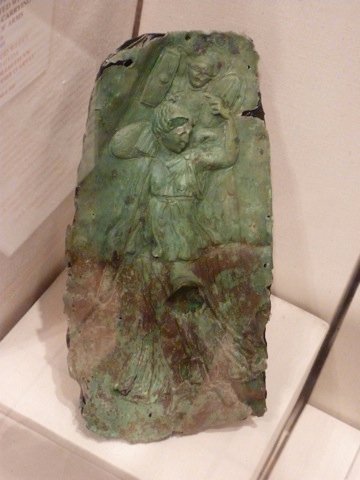
A bronze plaque depicting Victoria, a goddess favoured by many soldiers, for obvious reasons.
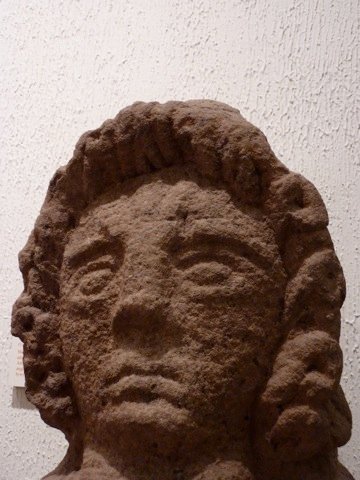
A rather sad-looking figure! Which makes sense, as it was found in a cemetery outside the fortress. It also makes sense because he is Attis, who castrated himself in a fit of madness.

The most famous Roman remnant at Caerleon is probably the amphitheater.

It’s in ruins now, but its solidity gives a good idea of the importance it would have had for the local Romans. It would have sat around 6000 people, which is just about the complement of a full legion.

The amphitheater was built in the last decade of the first century; I’m not sure it’s up to modern OH&S standards. Then again, if you trip over and break something, the Roman army isn’t around to sue anymore.

One wonders who passed under this arch. What did they see, or do here? (This may be the arch the gladiators entered from.)

The modern town of Caerleon actually lies within the walls of the Roman fortress. It must have been an even more impressive sight in the Middle Ages. It has certainly had a disproportionate effect on literary types. Geoffrey of Monmouth used it in his Arthurian myth, as an appropriate seat of royal power. Much later, Tennyson wrote the ‘Idylls of the King’ here. And Arthur Machen wove it into into his tales of ancient and primeval horrors. (He was in fact born here, though I didn’t manage to find his house.)
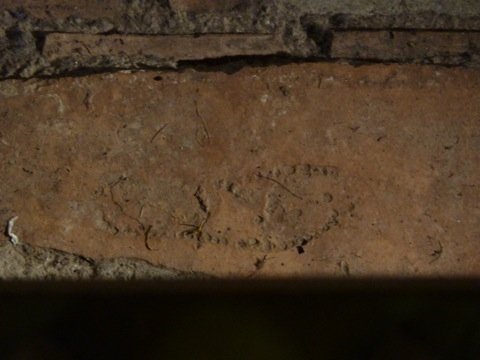
Last photo from Caerleon: the imprint of a workman’s boot from the frigidarium in the bath complex.
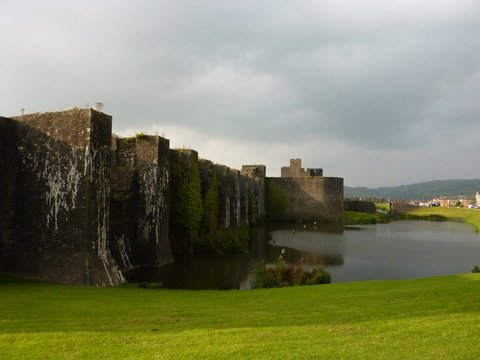
Caerphilly is not far from Caerleon as the crow flies, but it’s a moderate distance as the bus and train drives. I got there late in the afternoon, which turned out to be pretty good timing as far as the light was concerned.

Gilbert de Clare (or rather his workers) began building the castle in 1268. Over five hundred years later, the Butes began to restore it. (I must confess to preferring their work here than their parallel restoration of Cardiff Castle.)
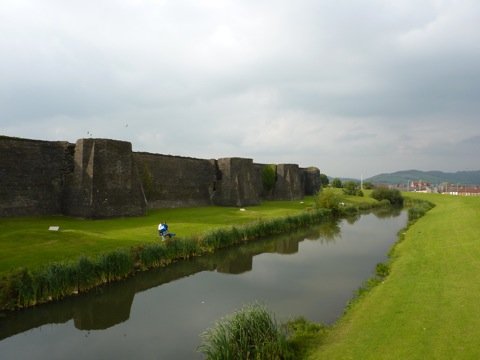
You can see what a big job it was. This photo and the preceding two are just the west walls (or rather dams), moving from north to south.

One of the striking features of Caerphilly Castle is the lake surrounding it, which was created in imitation of the defensive lake at Kenilworth Castle. (Incidentally, I think one or the other of the two peaks in the background is Caerphilly Mountain, where C. Lethbridge had his close encounter with a phantom airship.)
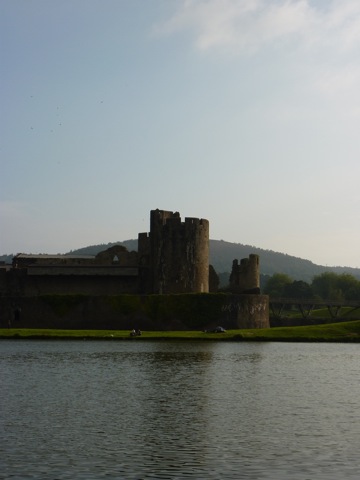
Gilbert had seen for himself how effective water defences were during Simon de Montfort’s rebellion, when Kenilworth withstood a siege by the king’s forces for most of 1266.

The lake proved to be a far-sighted idea. At least as far as anglers are concerned.

A view from the other side. You can see that after getting past the lake, an attacking army would still face a formidable array of walls and towers. Defence in depth!

It’s romantic but probably wrong to imagine that this tower leans due to battle damage. More likely it’s just ground subsidence. But it’s somewhat surprising that we don’t actually know for sure.

It’s leaning at an angle of 10 degrees, and I was surprised that there are no external braces to prop it up. Still, it’s lasted this long; no doubt she’ll be right.

Siege engines! The one in the centre is a trebuchet, and on the right is a perrier (a man-powered trebuchet). They’re fully-functional reconstructions, and from time to time are used to fling things into the lake.

Gilbert built the castle to frustrate the ambitions of Llewelyn ap Gruffudd, Prince of Wales. Llewelyn’s forces actually raided and burnt it while it was under construction, but within a few years Edward I began his campaign to conquer Wales and Caerphilly was no longer on the frontier.

That doesn’t mean it didn’t see any action, particularly since the Welsh didn’t take well to being conquered. It may have been attacked in 1294 or 1295 by Prince Madoc. Llwellyn Bren started his rebellion in 1316 by attacking Caerphilly Castle with an army of perhaps 10,000. He didn’t take it, but did destroy the town.

In 1326, Edward II and Hugh Despencer stayed here while on the run from the forces of Edward’s queen, Isabella, and Roger Mortimer. They must have regretted leaving the safety of its walls for an abbey at Neath, because they were captured upon trying to return to Caerphilly. Both men met an unfortunate end before the year was out.

Oddly, whereas the Cadw guidebook simply says we can’t tell what part Caerphilly played in the great rebellion of Owain Glyndwr, if any, Wikipedia says he captured it twice, in 1403 and 1405, holding it for a hundred days and a year respectively. [Citation needed], I think.
Above is the eastern gatehouse, much restored by the Butes.
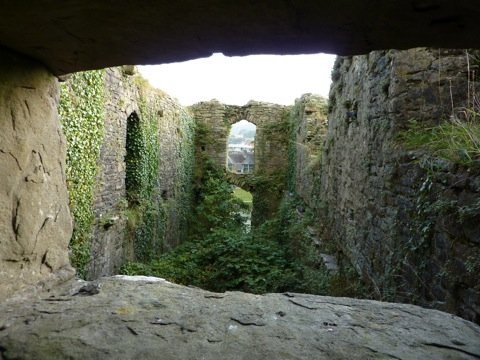
This passage led from the Great Hall (which I didn’t get a good look at, since there was a wedding reception being held inside!) down to the lake. A portcullis would have guarded against anyone trying to sneak in the back way.
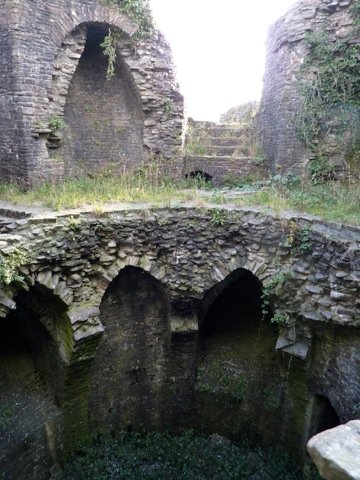
Inside the adjacent tower.

And I think this is looking along the side of the gatehouse.
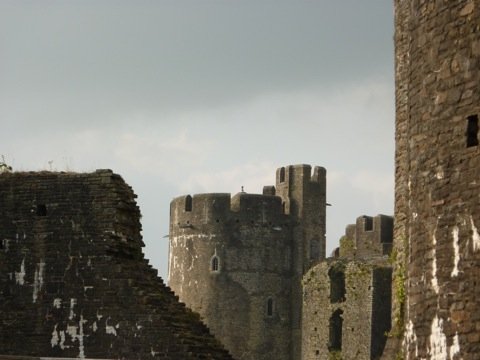
Caerphilly may have been damaged in the Civil War, perhaps through slighting (i.e. destroying the fortifications — obviously the job wasn’t finished, if so). But there’s no firm evidence. Although there’s a redoubt from that period on the north-west side of the lake (on top of a Roman fort, in fact), it’s not clear whether it was erected by the Royalists (perhaps in 1645, when Prince Rupert was nearby) or the Parliamentarians.

After that, the castle continued to decay. The Butes restored it over four generations, and in 1950 the fifth gave it to the nation. And I hope the nation is grateful, because it’s a magnificent gift indeed.
![]() This work is licensed under a Creative Commons Attribution-NonCommercial-NoDerivatives 4.0 International License.
Permissions beyond the scope of this license may be available at http://airminded.org/copyright/.
This work is licensed under a Creative Commons Attribution-NonCommercial-NoDerivatives 4.0 International License.
Permissions beyond the scope of this license may be available at http://airminded.org/copyright/.

